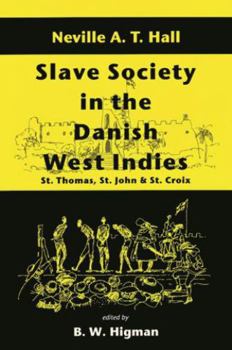Slave Society in the Danish West Indies: St. Thomas, St. John and St. Croix
Select Format
Select Condition 
Book Overview
Slave Society
in the Danish West Indies provides a rich account of the
development and destruction of slavery in St. Thomas, St. John and St. Croix,
the Caribbean islands which today comprise the United States Virgin Islands. It
sees slavery as fundamental to the entire fabric of colonial society and pays
particular attention to the political and social life of the whites and
freedmen in interaction with the slaves. The Danish West Indian colonies contained a small but significant
part of the slave population of the Caribbean. Each of the islands had a
distinct history during the period of slavery: St. Croix was the scene of a
full-blown sugar plantation economy; St. Thomas served as a major entrepot,
with a small plantation sector and a large role in the transatlantic slave
trade; St. John developed as a plantation economy but for various reasons the
slaves came to engage in relatively independent economic activity. Resistance to slavery was persistent, with important rebellions
occuring in St. John and St. Croix. Although Denmark was the first European
nation to abolish the slave trade, emancipation did not come until 1848, so
that the gap between abolition and emancipation was longer than in most
territories. The Danish West Indies also saw unique attempts at the
amelioration of the slave system, such as the establishment of schools for
slaves. Thus the study of slave society in the Danish West Indies has much to
tell about the nature of Caribbean history generally.
makes a truly original contribution to the understanding of slave societies
throughout the Americas.
in the Danish West Indies provides a rich account of the
development and destruction of slavery in St. Thomas, St. John and St. Croix,
the Caribbean islands which today comprise the United States Virgin Islands. It
sees slavery as fundamental to the entire fabric of colonial society and pays
particular attention to the political and social life of the whites and
freedmen in interaction with the slaves. The Danish West Indian colonies contained a small but significant
part of the slave population of the Caribbean. Each of the islands had a
distinct history during the period of slavery: St. Croix was the scene of a
full-blown sugar plantation economy; St. Thomas served as a major entrepot,
with a small plantation sector and a large role in the transatlantic slave
trade; St. John developed as a plantation economy but for various reasons the
slaves came to engage in relatively independent economic activity. Resistance to slavery was persistent, with important rebellions
occuring in St. John and St. Croix. Although Denmark was the first European
nation to abolish the slave trade, emancipation did not come until 1848, so
that the gap between abolition and emancipation was longer than in most
territories. The Danish West Indies also saw unique attempts at the
amelioration of the slave system, such as the establishment of schools for
slaves. Thus the study of slave society in the Danish West Indies has much to
tell about the nature of Caribbean history generally.
Based on extensive research in the Copenhagen archives, Slave Society in the Danish West Indies
makes a truly original contribution to the understanding of slave societies
throughout the Americas.
Format:Paperback
Language:English
ISBN:9764100295
ISBN13:9789764100294
Release Date:May 1994
Publisher:University of the West Indies Press
Length:316 Pages
Weight:1.20 lbs.
Dimensions:0.7" x 6.0" x 9.0"
Customer Reviews
0 rating





